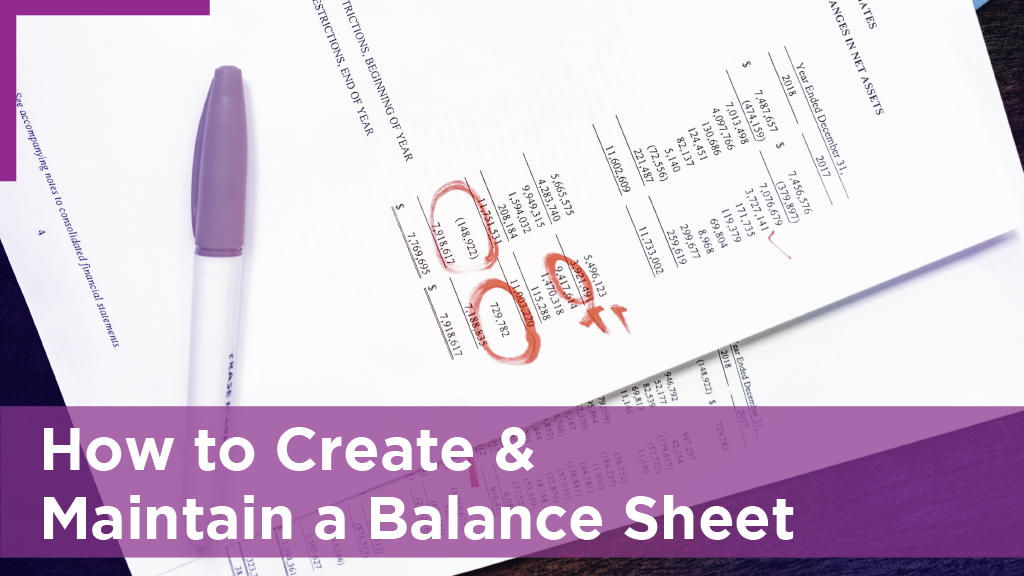
Have you ever wondered how to create & maintain a balance sheet?
The balance sheet provides a summary of your company’s financial situation as of a particular date. The balance sheet explains in non-accounting words what your company possesses (assets), what it owes (liabilities), and what the owner’s interest in the company is (equity).
Essentially, if the financial statements are the story of your company, the balance sheet is the CliffsNotes. Your balance sheet gives you a clear image of what you own and what you owe, as well as a summary of your company’s financial status at a particular point in time. Below you will find information on how to create & maintain a balance sheet.
What are the main parts of a balance sheet?
1. Assets
Assets are the items that your company owns. They are often divided into two sections on balance sheets.
Current assets
Firstly, current assets include cash and other assets that you anticipate selling in the upcoming year. As such, inventory and accounts receivable are examples of current assets.
Fixed assets
Secondly, fixed assets are owned assets or equipment that the business uses to generate revenue from its operations. Fixed assets are things that will not likely be sold and that are bought for a lengthy period of time (longer than one year). As a result of wear and tear, their value depreciates over time. On the income statement, this modification is noted as depreciation.
2. Liabilities
Liabilities are the sums that your company owes to third parties in the next 12 months. More specifically, balance sheets divide liabilities into two divisions. Current liabilities and long-term liabilities.
Examples of current liabilities include accounts payable, credit card bills, sales taxes collected, payroll liabilities, and loan payments. Whereas, examples of long-term liabilities are term loans and mortgages.
3. Shareholders’ Equity
Shareholders’ equity is the value of the company’s obligation to shareholders. It is what the company owes you.
Equity includes:
- The amount of money put into the business by its shareholders (startup cash you invested, etc.)
- The amount of money generated by a business (amounts you have left in the business over time.)
- Any donated capital.
- Calculated equity using this formula: Equity = Total Assets – Total Liabilities
A Balance Sheet Preparation Guide
To produce an accurate balance sheet, you can use your accounting software. In every program designed for double-entry bookkeeping, the balance sheet is a standard report.
Firstly, go to the reports section of your accounting program and search for financial reports. The balance sheet should be near the top of the list, frequently right after the profit and loss (or income) statement because it is a common financial statement.
For the balance sheet report, some accounting software asks you to specify a time range. This can sometimes cause confusion. The balance sheet displays information as of a certain date. However, the profit and loss statement only displays information for a specific time period.
Furthermore, along with a financial overview of your company from the beginning to the balance sheet’s “as of” date, this data also provides a financial summary of your company.
The balance sheet’s objective
Primarily, balance sheets are utilized as a method for determining whether or not the accounting procedure produced accurate results. It is easy to spot an error on the balance sheet if assets do not match liabilities plus equity.
Contemporary accounting software does not allow for the recording of transactions that are not balanced, uneven balance sheets are an extremely rare occurrence. An uneven balance sheet typically denotes a software-related issue. Nowadays, balance sheets aren’t needed anymore. However, the balance sheet helps you measure your company’s health and make informed business decisions.
In short, a balance sheet is a critical tool for assessing your company’s health and making prudent business decisions.
How to make business decisions using your balance sheet
With a quick glance at the balance sheet, you can assess the financial health of your company. If equity is negative, which means liabilities exceed assets, that may be a sign that your company is having financial problems. Schedule a meeting with your accountant to discuss this.
Further, you can identify three key parameters from your company’s balance statement.
Current ratio
The current ratio gauges the capacity of your company to meet its short-term obligations. The equation is: Current ratio is equal to Current Assets / Current Liabilities.
The current ratio reveals how many times your company’s available cash can cover its current liabilities. Anything below 1 means your company won’t have enough cash or cash equivalents to cover its obligations over the course of the next 12 months.
Quick ratio
This is the quick ratio formula: Quick ratio: Current liabilities / (Cash & cash equivalents + Short-term investments + Accounts receivable)
The quick ratio, which measures liquidity, is frequently identical to the current ratio.
The ratio of debt to equity
The debt-to-equity ratio reveals how much of your company is financed by debt, or how leveraged it is.
The equation is: Debt-to-equity ratio = Total Liabilities / Total Equity
Keep in mind that we are now examining all liabilities, including long-term debt. Between 1 and 1.5 is a healthy debt-to-equity ratio. Anything above that may be a sign that your company is heavily leveraged. This can make it more difficult to find financing at a good rate.
Things to consider
The ratios are useful for making fast assessments of how well your company is performing in a few key areas. Evaluate the balance sheet, the profit and loss, and the cash flow statement in order to make good business decisions.
 Email This Post
Email This Post


